Exploring Flatland and Well-being in Business and Culture: A Journal
VerifiedAdded on 2021/02/19
|5
|975
|16
Journal and Reflective Writing
AI Summary
This journal entry examines the concept of Flatland, a two-dimensional world, and its application to business and culture. The author explores how authors use Flatland to define societal structures and their impact on business practices, particularly in the context of Maori businesses. The journal discusses the authors' perspectives on relational, spiritual, and environmental well-being, contrasting them with other forms of well-being. The analysis focuses on the ethic of care within businesses and how creating a positive environment can foster success. The author also compares the authors' ideas on well-being to their own cultural perspectives, emphasizing the importance of protective and caring behaviors in the workplace. The journal references key articles and books to support its arguments, highlighting the significance of these concepts in the business world.
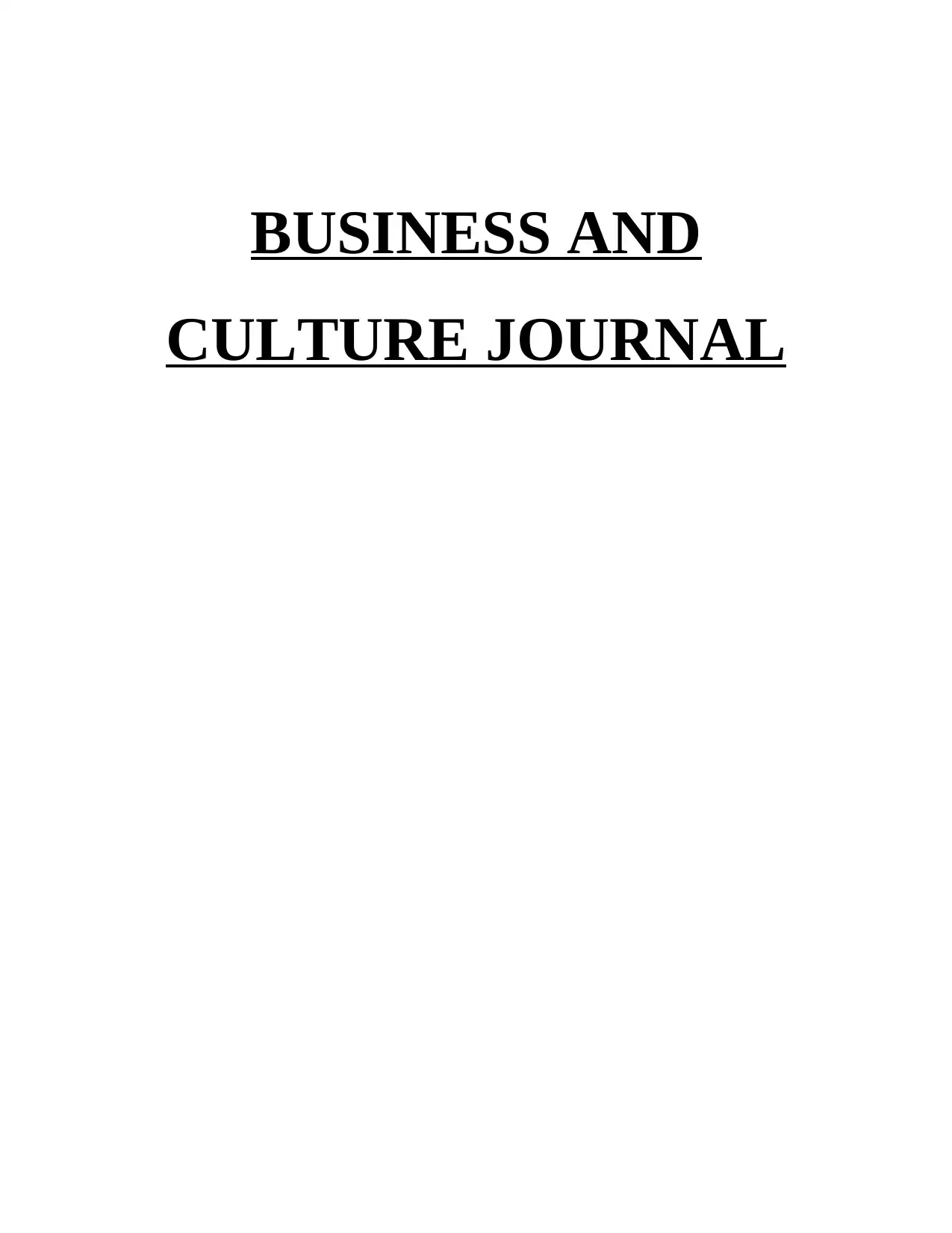
BUSINESS AND
CULTURE JOURNAL
CULTURE JOURNAL
Paraphrase This Document
Need a fresh take? Get an instant paraphrase of this document with our AI Paraphraser
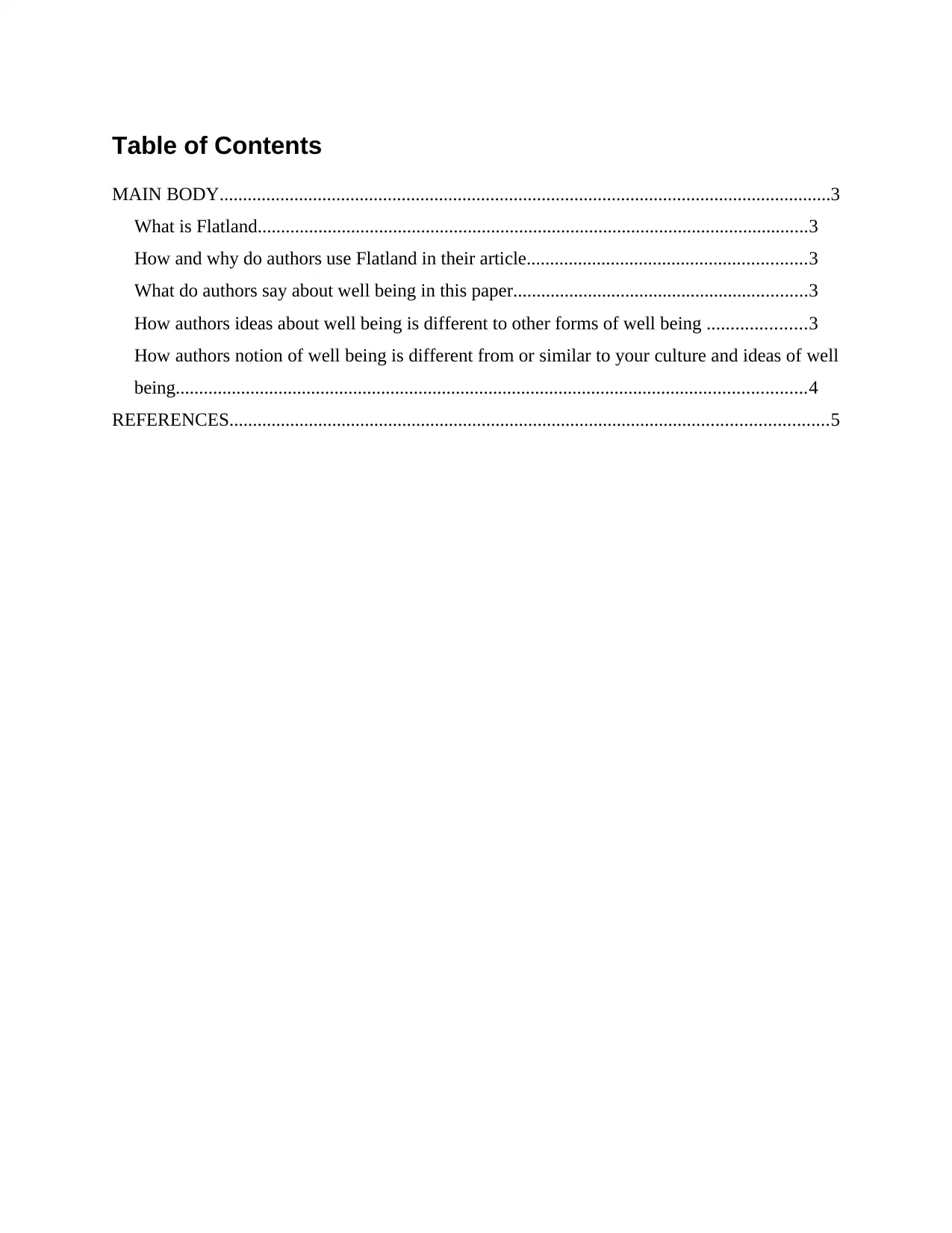
Table of Contents
MAIN BODY...................................................................................................................................3
What is Flatland......................................................................................................................3
How and why do authors use Flatland in their article............................................................3
What do authors say about well being in this paper...............................................................3
How authors ideas about well being is different to other forms of well being .....................3
How authors notion of well being is different from or similar to your culture and ideas of well
being.......................................................................................................................................4
REFERENCES................................................................................................................................5
MAIN BODY...................................................................................................................................3
What is Flatland......................................................................................................................3
How and why do authors use Flatland in their article............................................................3
What do authors say about well being in this paper...............................................................3
How authors ideas about well being is different to other forms of well being .....................3
How authors notion of well being is different from or similar to your culture and ideas of well
being.......................................................................................................................................4
REFERENCES................................................................................................................................5
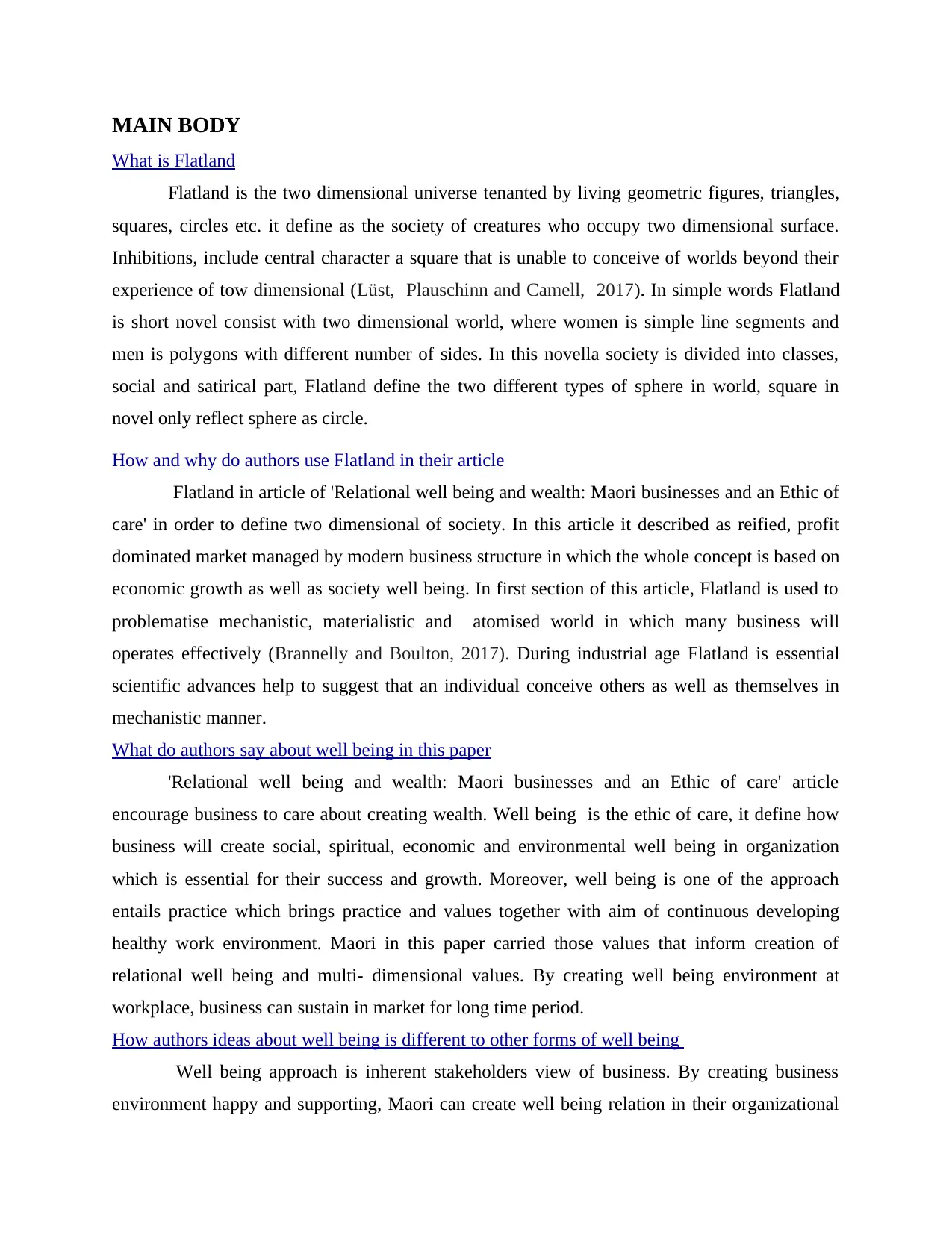
MAIN BODY
What is Flatland
Flatland is the two dimensional universe tenanted by living geometric figures, triangles,
squares, circles etc. it define as the society of creatures who occupy two dimensional surface.
Inhibitions, include central character a square that is unable to conceive of worlds beyond their
experience of tow dimensional (Lüst, Plauschinn and Camell, 2017). In simple words Flatland
is short novel consist with two dimensional world, where women is simple line segments and
men is polygons with different number of sides. In this novella society is divided into classes,
social and satirical part, Flatland define the two different types of sphere in world, square in
novel only reflect sphere as circle.
How and why do authors use Flatland in their article
Flatland in article of 'Relational well being and wealth: Maori businesses and an Ethic of
care' in order to define two dimensional of society. In this article it described as reified, profit
dominated market managed by modern business structure in which the whole concept is based on
economic growth as well as society well being. In first section of this article, Flatland is used to
problematise mechanistic, materialistic and atomised world in which many business will
operates effectively (Brannelly and Boulton, 2017). During industrial age Flatland is essential
scientific advances help to suggest that an individual conceive others as well as themselves in
mechanistic manner.
What do authors say about well being in this paper
'Relational well being and wealth: Maori businesses and an Ethic of care' article
encourage business to care about creating wealth. Well being is the ethic of care, it define how
business will create social, spiritual, economic and environmental well being in organization
which is essential for their success and growth. Moreover, well being is one of the approach
entails practice which brings practice and values together with aim of continuous developing
healthy work environment. Maori in this paper carried those values that inform creation of
relational well being and multi- dimensional values. By creating well being environment at
workplace, business can sustain in market for long time period.
How authors ideas about well being is different to other forms of well being
Well being approach is inherent stakeholders view of business. By creating business
environment happy and supporting, Maori can create well being relation in their organizational
What is Flatland
Flatland is the two dimensional universe tenanted by living geometric figures, triangles,
squares, circles etc. it define as the society of creatures who occupy two dimensional surface.
Inhibitions, include central character a square that is unable to conceive of worlds beyond their
experience of tow dimensional (Lüst, Plauschinn and Camell, 2017). In simple words Flatland
is short novel consist with two dimensional world, where women is simple line segments and
men is polygons with different number of sides. In this novella society is divided into classes,
social and satirical part, Flatland define the two different types of sphere in world, square in
novel only reflect sphere as circle.
How and why do authors use Flatland in their article
Flatland in article of 'Relational well being and wealth: Maori businesses and an Ethic of
care' in order to define two dimensional of society. In this article it described as reified, profit
dominated market managed by modern business structure in which the whole concept is based on
economic growth as well as society well being. In first section of this article, Flatland is used to
problematise mechanistic, materialistic and atomised world in which many business will
operates effectively (Brannelly and Boulton, 2017). During industrial age Flatland is essential
scientific advances help to suggest that an individual conceive others as well as themselves in
mechanistic manner.
What do authors say about well being in this paper
'Relational well being and wealth: Maori businesses and an Ethic of care' article
encourage business to care about creating wealth. Well being is the ethic of care, it define how
business will create social, spiritual, economic and environmental well being in organization
which is essential for their success and growth. Moreover, well being is one of the approach
entails practice which brings practice and values together with aim of continuous developing
healthy work environment. Maori in this paper carried those values that inform creation of
relational well being and multi- dimensional values. By creating well being environment at
workplace, business can sustain in market for long time period.
How authors ideas about well being is different to other forms of well being
Well being approach is inherent stakeholders view of business. By creating business
environment happy and supporting, Maori can create well being relation in their organizational
⊘ This is a preview!⊘
Do you want full access?
Subscribe today to unlock all pages.

Trusted by 1+ million students worldwide
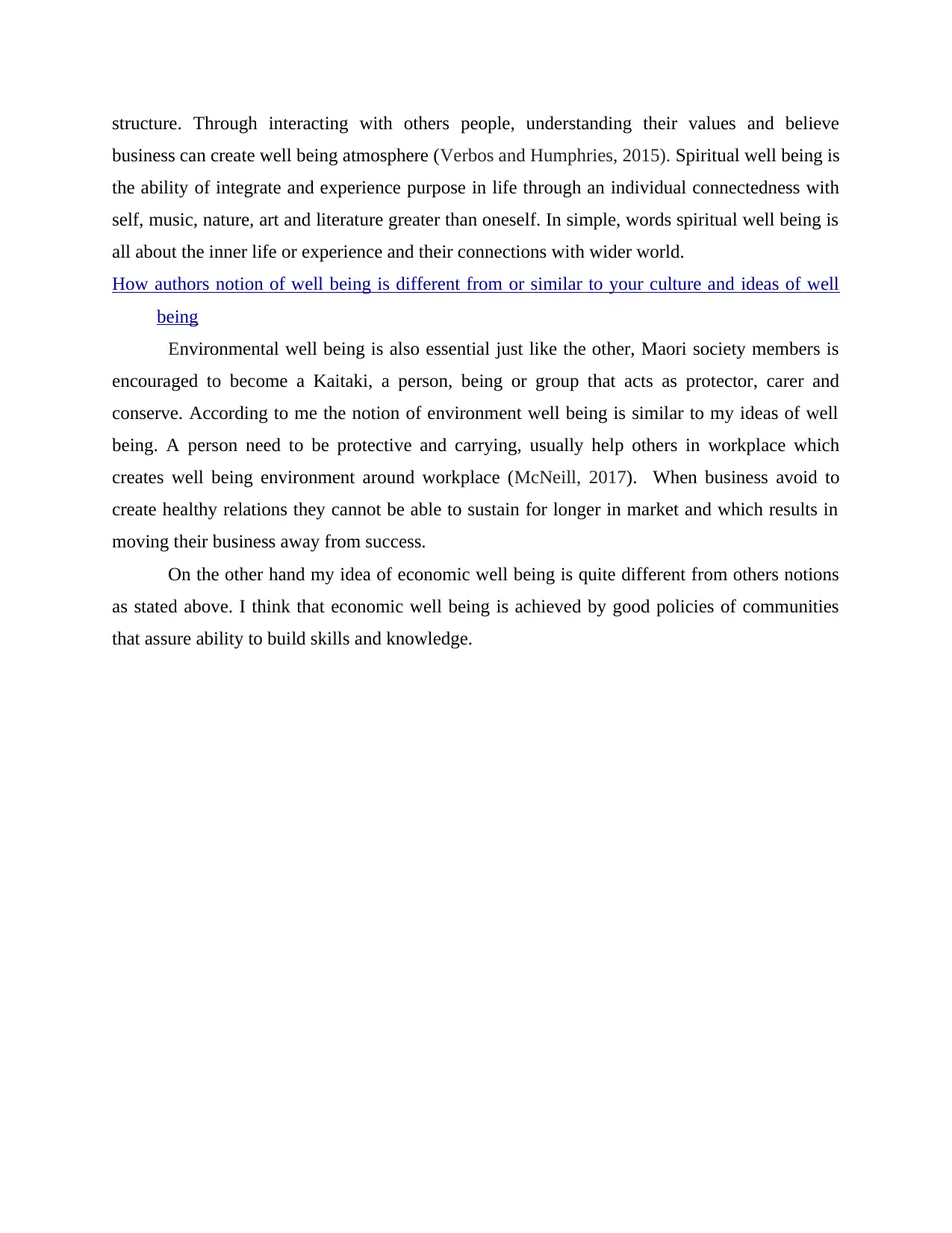
structure. Through interacting with others people, understanding their values and believe
business can create well being atmosphere (Verbos and Humphries, 2015). Spiritual well being is
the ability of integrate and experience purpose in life through an individual connectedness with
self, music, nature, art and literature greater than oneself. In simple, words spiritual well being is
all about the inner life or experience and their connections with wider world.
How authors notion of well being is different from or similar to your culture and ideas of well
being
Environmental well being is also essential just like the other, Maori society members is
encouraged to become a Kaitaki, a person, being or group that acts as protector, carer and
conserve. According to me the notion of environment well being is similar to my ideas of well
being. A person need to be protective and carrying, usually help others in workplace which
creates well being environment around workplace (McNeill, 2017). When business avoid to
create healthy relations they cannot be able to sustain for longer in market and which results in
moving their business away from success.
On the other hand my idea of economic well being is quite different from others notions
as stated above. I think that economic well being is achieved by good policies of communities
that assure ability to build skills and knowledge.
business can create well being atmosphere (Verbos and Humphries, 2015). Spiritual well being is
the ability of integrate and experience purpose in life through an individual connectedness with
self, music, nature, art and literature greater than oneself. In simple, words spiritual well being is
all about the inner life or experience and their connections with wider world.
How authors notion of well being is different from or similar to your culture and ideas of well
being
Environmental well being is also essential just like the other, Maori society members is
encouraged to become a Kaitaki, a person, being or group that acts as protector, carer and
conserve. According to me the notion of environment well being is similar to my ideas of well
being. A person need to be protective and carrying, usually help others in workplace which
creates well being environment around workplace (McNeill, 2017). When business avoid to
create healthy relations they cannot be able to sustain for longer in market and which results in
moving their business away from success.
On the other hand my idea of economic well being is quite different from others notions
as stated above. I think that economic well being is achieved by good policies of communities
that assure ability to build skills and knowledge.
Paraphrase This Document
Need a fresh take? Get an instant paraphrase of this document with our AI Paraphraser
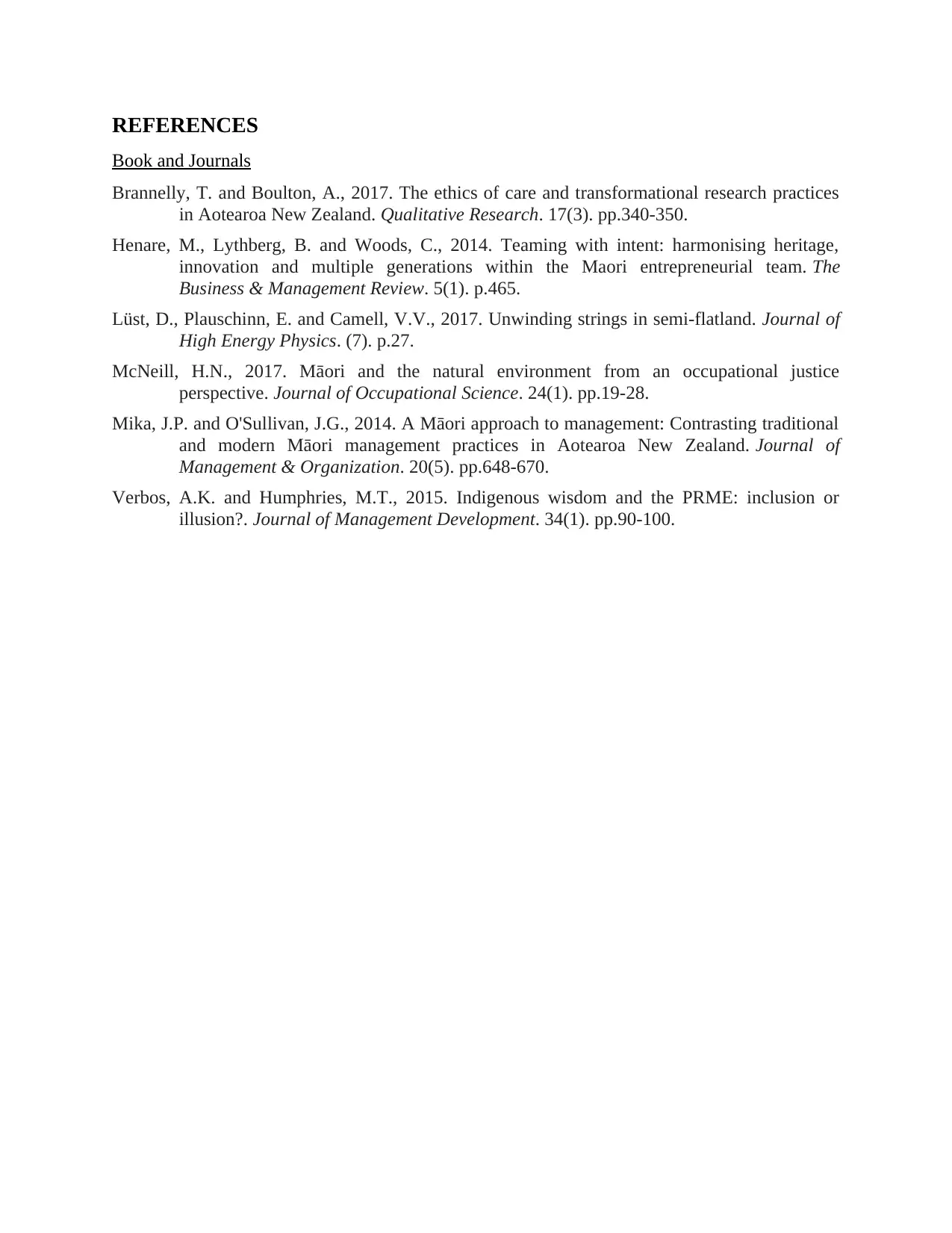
REFERENCES
Book and Journals
Brannelly, T. and Boulton, A., 2017. The ethics of care and transformational research practices
in Aotearoa New Zealand. Qualitative Research. 17(3). pp.340-350.
Henare, M., Lythberg, B. and Woods, C., 2014. Teaming with intent: harmonising heritage,
innovation and multiple generations within the Maori entrepreneurial team. The
Business & Management Review. 5(1). p.465.
Lüst, D., Plauschinn, E. and Camell, V.V., 2017. Unwinding strings in semi-flatland. Journal of
High Energy Physics. (7). p.27.
McNeill, H.N., 2017. Māori and the natural environment from an occupational justice
perspective. Journal of Occupational Science. 24(1). pp.19-28.
Mika, J.P. and O'Sullivan, J.G., 2014. A Māori approach to management: Contrasting traditional
and modern Māori management practices in Aotearoa New Zealand. Journal of
Management & Organization. 20(5). pp.648-670.
Verbos, A.K. and Humphries, M.T., 2015. Indigenous wisdom and the PRME: inclusion or
illusion?. Journal of Management Development. 34(1). pp.90-100.
Book and Journals
Brannelly, T. and Boulton, A., 2017. The ethics of care and transformational research practices
in Aotearoa New Zealand. Qualitative Research. 17(3). pp.340-350.
Henare, M., Lythberg, B. and Woods, C., 2014. Teaming with intent: harmonising heritage,
innovation and multiple generations within the Maori entrepreneurial team. The
Business & Management Review. 5(1). p.465.
Lüst, D., Plauschinn, E. and Camell, V.V., 2017. Unwinding strings in semi-flatland. Journal of
High Energy Physics. (7). p.27.
McNeill, H.N., 2017. Māori and the natural environment from an occupational justice
perspective. Journal of Occupational Science. 24(1). pp.19-28.
Mika, J.P. and O'Sullivan, J.G., 2014. A Māori approach to management: Contrasting traditional
and modern Māori management practices in Aotearoa New Zealand. Journal of
Management & Organization. 20(5). pp.648-670.
Verbos, A.K. and Humphries, M.T., 2015. Indigenous wisdom and the PRME: inclusion or
illusion?. Journal of Management Development. 34(1). pp.90-100.
1 out of 5
Related Documents
Your All-in-One AI-Powered Toolkit for Academic Success.
+13062052269
info@desklib.com
Available 24*7 on WhatsApp / Email
![[object Object]](/_next/static/media/star-bottom.7253800d.svg)
Unlock your academic potential
Copyright © 2020–2025 A2Z Services. All Rights Reserved. Developed and managed by ZUCOL.




